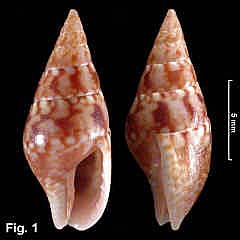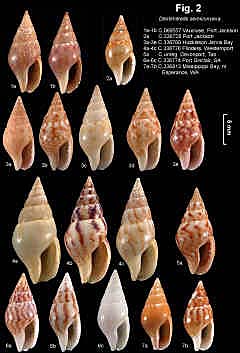|
|
|
|
|
Mitrella semiconvexa (Lamarck, 1822) Description: Shell broad (for the genus), whorls rounded, spire straight sided or very slightly convex, aperture 40% of shell length. Protoconch of 1¼ smooth whorls. Spiral sculpture restricted to cords on base; axial sculpture absent. Outer lip weakly sinuous in profile, with very shallow posterior sinus; lip not thickened externally, thickened internally, with 7-10 denticles. Columella callus sharp-edged with 5 denticles on the outer edge in mature shells, otherwise with spiral sculpture showing through. Siphonal canal very short. Colour variable, but with several predominant patterns: (a) uniformly white, fawn, orange or pink (b) with axial zigzag brown flames (c) with spots in quincunx pattern (d) with spiral bands. Interior white or mauve. Periostracum thin, smooth. Size: Adults 12-21 mm in length; NSW specimens usually at the lower end of the range. Distribution: Endemic to Australia; Brunswick Heads, NSW, around southern Australia to Cape Naturaliste, south-western WA, including Tasmania. Habitat: This species lives on algae and under stones on rocky shores, low intertidal and shallow subtidal. Common in southern Australia. Uncommon around Sydney, rare north of Sydney. Comparison: M. semiconvexa is similar in size, shape and colour to M. australis, and can only be separated if protoconch and periostracum are present. M. australis has a frilled periostracum, while that of M. semiconvexa is smooth. M. australis has a protoconch much larger than that of M. semiconvexa. For specimens without the protoconch and the periostracum, the two species are almost impossible to tell apart, except that M. semiconvexa tends to be broader. M. australis often has a spiral groove below the suture at the position of the frilled periostracal band, and the outer lip has an axial fold. The ranges of the two species only overlap in northern NSW, and M. australis is the more common in the overlap zone; the southern limit for M. australis is Sydney, while the northern limit of M. semiconvexa is Brunswick Heads. Large specimens of M. semiconvexa can usually be distinguished from other species of the genus by size, as the others do not exceed 16 mm in length. But small shells and worn and juvenile specimens are very difficult to identify positively. The colour pattern of M. semiconvexa is variable, and overlaps that of the other species, and shell shape is not sufficiently different to be a useful character. Synonymy: Columbella strigata Reeve, 1859 is a synonym. Many other synonyms have been proposed but it is beyond the scope of this work to resolve them.. Remarks: The biology of this species has been described in an unpublished (possibly unsubmitted) M.Sc. thesis by Springsteen (1989). Fig. 1: Huskisson, Jervis Bay, NSW (C.336760) Fig. 2: Variation |

